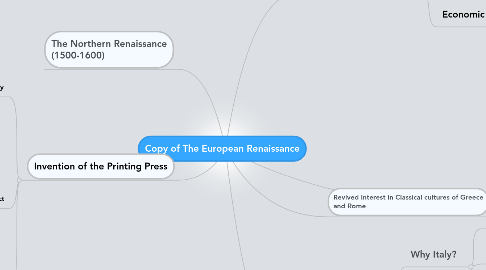
1. The Northern Renaissance (1500-1600)
2. Invention of the Printing Press
2.1. Popularity
2.1.1. By 1482 - 100 printing presses in Western Europe
2.1.1.1. 50 in Italy
2.1.1.2. 9 in France
2.1.1.3. 30 in Germany
2.1.1.4. 8 in Spain and Holland
2.1.1.5. 4 in England
2.2. Impact
2.2.1. Spread new religious ideas and concerns
2.2.1.1. The vast number of copies of these made it difficult for the Church to censor
2.2.1.2. Leads to the Protestant Reformation
2.2.2. Spread information quickly and accurately
2.2.3. Created a wider literate reading public
2.2.4. Spread scientific and political ideas that were shared and read all over Europe
2.2.4.1. Leads to the Scientific Revolution and the Enlightenment
2.3. Some say the printing press is the most important invention between writing itself and the computer
3. Europe's New Economy
3.1. Social Changes
3.1.1. Nobles decline in status
3.1.1.1. Labor shortages = high prices
3.1.1.1.1. Land worth less and static
3.1.1.1.2. Peasant able to buy freedom
3.1.2. Peasants rise in status
3.1.2.1. Greater incentives to work
3.1.2.2. Creates "Middle Class"
3.1.2.2.1. Middle class assumed a larger role in governments.
3.1.3. For kings, the nobles were the main obstacle to building strong nation-states.
3.1.3.1. The alliance of kings and the middle class gave kings the most power.
3.2. Economic Revival
3.2.1. Strong monarchies safeguarded the peace and promoted trade and commerce.
3.2.1.1. Joint stock companies
3.2.1.2. Insurance companies
3.2.1.3. Deposit banks and credit
3.2.2. New Business Techniques
3.2.2.1. Capitalism
3.2.2.1.1. Dangers with this system if debtors cannot repay creditors.
3.2.2.1.2. Investment - production - jobs - more money to spend, so on...
3.2.2.1.3. Law of Supply and Demand determines prices.
3.2.2.1.4. The reviving economy needed more resources, prompts Spain and Portugal to search for new trade routes - discovering whole new continents and expanding trade.
3.2.2.1.5. Little contact between workers and business owners. - problems later (Ind. Rev)
3.2.2.1.6. The profit motive
3.2.2.2. More silver in circulation due to better mining in Germany
3.2.2.3. The use of Arabic numerals improved accounting techniques - more efficient
3.2.3. Climate improved = population grew (50 mil. by 1450 to 70 mil. by 1500.
3.2.4. New consumer markets
3.2.4.1. When the nobles had the wealth they bought expensive, high quality products.
3.2.4.2. Now, the middle class bought cheaper, lower quality products - but more production needed.
3.2.4.3. Businessmen would buy cheap materials and undersell the guilds.
3.2.4.4. The longbow, gunpowder, canons, and mass formations of infantry challenged the knight's supremacy.
4. Rise of the nation state
5. Revived interest in Classical cultures of Greece and Rome
6. The Italian Renaissance (1400-1550)
6.1. Why Italy?
6.1.1. Geographic location
6.1.1.1. Upon the ruins of Rome
6.1.1.2. Trade $$$
6.1.2. Printing Press
6.1.2.1. New ideas spread quickly and were hard to censor
6.1.3. Urban Culture and Vibrant Economy of the City-State
6.1.3.1. Wealth and Freedom of Expression
6.1.3.2. Universities
6.2. New Patterns of Thought
6.2.1. Secularism
6.2.1.1. Secular meaning "of this world"
6.2.2. Humanism
6.2.2.1. Makes human beings, not God, the center of attention
6.2.2.2. Renaissance philosophers often "Humanists", who saw humans as intelligent creatures capable of reason (and questioning authority)
6.2.3. Individualism
6.2.3.1. Believed individuals were capable of great accomplishments
6.2.4. Skepticism
6.2.4.1. Promoted curiosity and the questioning of authority.
6.3. Literature and Learning
6.3.1. Life is worth living for its own sake - not just afterlife
